Labster simulation Study guides, Class notes & Summaries
Looking for the best study guides, study notes and summaries about Labster simulation? On this page you'll find 121 study documents about Labster simulation.
Page 4 out of 121 results
Sort by
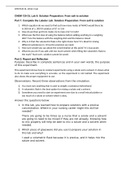
-
CHEM 120 OL Lab 6: Solution Preparation: From salt to solution
- Exam (elaborations) • 2 pages • 2022
-
- $12.49
- 1x sold
- + learn more
CHEM 120 OL Lab 6: Solution Preparation: From salt to solution Part 1: Complete the Labster Lab: Solution Preparation: From salt to solution 1. Which equation do we need to find out how many moles of NH4Cl would there be in 500 ml of a .300 M solution of it? n= CxV 2. How do we then get from moles (n) to mass (m)? m=nxM 3. What was the first step of using the balance before adding anything to a weighing dish? Tare the balance with the weighing dish and the balance closed 4. Why is it that t...
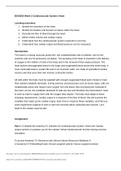
-
BIOS-255 Week 2 Assignment: The Cardiovascular System: Heart (graded)
- Exam (elaborations) • 6 pages • 2022
- Available in package deal
-
- $10.99
- + learn more
BIOS255 Week 2 Cardiovascular System: Heart Learning outcomes: 1. Identify the chambers of the heart. 2. Identify the location and function of valves within the heart. 3. Describe the flow of blood through the heart. 4. Define stroke volume and cardiac output. 5. Understand how the cardiovascular system responds to exercise. 6. Understand how cardiac output and blood pressure can be measured. Introduction: The heart is a strong muscular pump with two complementary sets of arteries: ...
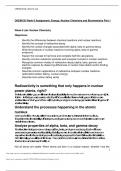
-
CHEM120 Week 6 Assignment: Energy, Nuclear Chemistry and Biochemistry Part 1
- Other • 6 pages • 2024
- Available in package deal
-
- $10.99
- + learn more
CHEM120 Week 6 Assignment: Energy, Nuclear Chemistry and Biochemistry Part 1 Week 6 Lab: Nuclear Chemistry Objectives: • Identify the differences between chemical reactions and nuclear reactio ns. • Identify the concept of radioactive decay. • Identify the nuclear changes associated with alpha, beta or gamma decay. • Write the products of nuclear reactions involving alpha, beta or gamma emissions. • Explain the concept of half-lives and complete half-life calculations. • Identify com...
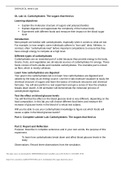
-
BIOS-256 Week 1 OL Lab 1: Carbohydrates The sugars that feed us | Already GRADED A
- Exam (elaborations) • 3 pages • 2022
- Available in package deal
-
- $10.99
- + learn more
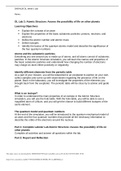
-
CHEM120 Atomic Structure: Assess the possibility of life on other planets OL, Week 1 Lab.
- Exam (elaborations) • 4 pages • 2022
- Available in package deal
-
- $4.99
- + learn more
CHEM120 Atomic Structure: Assess the possibility of life on other planets OL, Week 1 Lab. Learning Objectives Explain the concept of an atom Explain the properties of the basic subatomic particles: protons, neutrons, and electrons Define the atomic number and atomic mass Define isotopes Identify the basics of the quantum atomic model and describe the significance of the four quantum numbers Atoms and the subatomic particles Everything you see around you is made up o...
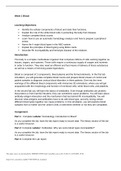
-
BIOS 255 Week 1 Discussion: Blood | Download To Score An A | Chamberlain College of Nursing
- Other • 5 pages • 2022
- Available in package deal
-
- $10.99
- + learn more
Week 1 Blood Learning Objectives: Identify the cellular components of blood and state their functions. Explain the role of the white blood cells in protecting the body from disease. An alyze complete blood counts. Learn how to use an automatic hematology analyzer and how to prepare a peripheral smear. Name the 4 major blood types in the ABO system. Explain the principles of blood typing using Eldon cards. Describe Rh incompatibility and hemolytic disease of the newbor...
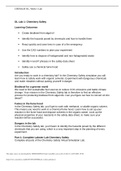
-
CHEM-120 Unit 1 Lab: OL Lab 1: Chemistry Safety | Download To Score An A
- Other • 4 pages • 2022
- Available in package deal
-
- $10.99
- + learn more
CHEM 120 Unit 1 Lab: OL Lab 1: Chemistry Safety Learning Outcomes Create biodiesel from algal oil Identify the hazards posed by chemicals and how to handle them React quickly and save lives in c ase of a fire emergency Use the CAS numbers to plan your experiment Identify how to dispose of halogenated and non-halogenated waste Identify H and P phrases in the safety data sheet Safely use a chemical fume hood Introduction Are you ready to work in a chemistry lab? In the Chemistry Safety simulation ...
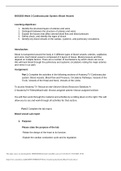
-
BIOS-255 Week 3 Assignment: Cardiovascular System: Blood Vessels | OPTION B | GRADED A
- Exam (elaborations) • 8 pages • 2022
- Available in package deal
-
- $10.99
- + learn more
BIOS255 Week 3 Cardiovascular System: Blood Vessels Learning objectives: 1. Identify the structural layers of arteries and veins. 2. Distinguish between the structure of arteries and veins. 3. Explain the factors that affect arterial blood flow and blood pressure. 4. Define shock, and identify the signs of shock. 5. Identify key blood vessels of the cardiac, systemic, and pulmonary circulations. Introduction: Blood is transported around the body in 3 different types of blood vessels: arteries, c...
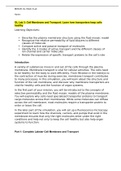
-
BIOS 251 Week 3 Lab: Cell Membrane and Transport-Learn how transporters keep cells healthy
- Exam (elaborations) • 6 pages • 2022
- Available in package deal
-
- $9.99
- + learn more
BIOS 251 Week 3 Lab: Cell Membrane and Transport-Learn how transporters keep cells healthy Learning Objectives: Describe the plasma membrane structure using the fluid mosaic model Recognize the relative permeability of lipid bilayers to different classes of molecule Compare active and passive transport of molecules Identify the 3 modes of active transport and the different classes of ion channel and carrier molecules Relate the expression of specific transport proteins to the cell’s ...
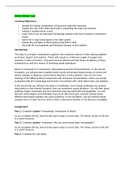
-
BIOS255 Week 1 Blood - Lab
- Other • 5 pages • 2022
-
- $20.49
- + learn more
Learning Objectives: o Identify the cellular components of blood and state their functions. o Explain the role of the white blood cells in protecting the body from disease. o Analyze complete blood counts. o Learn how to use an automatic hematology analyzer and how to prepare a peripheral smear. o Name the 4 major blood types in the ABO system. o Explain the principles of blood typing using Eldon cards. o Describe Rh incompatibility and hemolytic disease of the newborn. Introduction: Th...

Did you know that on average a seller on Stuvia earns $82 per month selling study resources? Hmm, hint, hint. Discover all about earning on Stuvia


